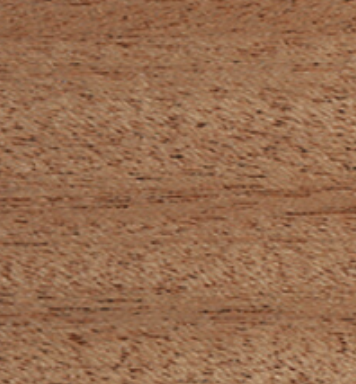How to choose the right type of wood?
As you probably know, there are hundreds of thousands of wood species, each with its own unique characteristics. So how can you choose from so many options?
In this article, we’ve tried to provide some guidelines to help you make a better choice when selecting your wood species. Depending on its intended use, the environment in which it will be placed, and its appearance, we will narrow down the options to finally choose the ideal wood from among those most commonly used in carpentry.
Characteristics
Identifying a type of wood means recognizing its properties through its visual appearance, smell, texture, density, and hardness. By visual appearance, we refer to the combination of its color, grain pattern, and texture.
1. Visual appearance
From black Ebony to red Mahogany, including yellow Itauba and white Sycamore Maple, there’s something for every taste! A wood's species, as well as its geographical origin and the richness of the soil in which the tree grows, all determine its unique final color.
The grain pattern—meaning the natural designs that appear on the wood’s surface—is influenced by the type of wood, its age, and especially the method of cutting. A radial cut reveals straight, parallel lines known as straight-grain wood. A tangential cut produces irregular patterns, referred to as flame-grain wood. Finally, a cross-section cut exposes the medullary rays, known as end-grain wood.
Source : lapins menuisier
Finally, the texture refers to the size of the anatomical elements—fibers and vessels—that make up the wood. A bit like pixels, a fine texture gives the impression of a smooth, uniform surface, while a coarse texture clearly reveals the wood’s structure and grain pattern.
2. Smell
The smell, which comes from the tannins or resins in the wood species, can be either subtle or persistent. In some cases, it even determines the wood’s usage—for example, ice cream sticks are typically made from beech wood, as it has virtually no odor.
3. Touch
Touch is another way to identify wood. While some surfaces feel oily, others may be more porous, soapy, or even fuzzy to the touch.
4. Density
Density relates to the wood’s moisture content. The higher the density, the harder and heavier the wood will be.
Wood classes
Each wood species has its own characteristics and properties, making some types more suitable for outdoor furniture, humid environments, or indoor applications. To properly assess the risks and suitable uses of wood, the NF EN 335-1 to 3 standard categorizes wood usage into 5 classes, which we’ve summarized below (from the lowest to the highest moisture exposure):
Class 1 : Indoor joinery (moisture content < 20%)
Class 2 : Structural frameworks (moisture content around 20%)
Class 3 : Protected outdoor joinery (moisture content > 20% without standing water)
Class 4 : Balconies, terraces, benches, etc. (moisture content > 20% with exposure to fresh standing water)
Class 5 : Docks and submerged wood (permanent contact with seawater)
That said, some treatments can increase a wood’s resistance to higher moisture levels. This allows for the use of class 1–2 woods instead of class 4–5, which tend to be much more expensive. However, these treatments are chemical, and we always prefer to rely on the wood’s natural performance—more environmentally friendly and often more effective.
Wood species
Beyond their intended use, woods are also classified according to their species. We distinguish two main categories: softwoods, which come from evergreen trees, and hardwoods, which come from deciduous trees. The hardwood category can be further divided into two groups: noble hardwoods and exotic hardwoods, which differ mainly in terms of geographical origin.
Aside from their aesthetic qualities, this classification is primarily based on the technical structure of the wood’s tissue. This structural difference affects not only the wood’s mechanical and thermal properties, but also its resistance to biological deterioration.
1. Softwoods
This category includes a large portion of forests in France and the Iberian Peninsula. As the name suggests, these are woods rich in resin or sap. They are appreciated for their light color and ease of use, which also makes them relatively inexpensive.
How can you recognize this type of wood?
Softwoods come from evergreen trees—those that keep their leaves year-round—and are often conical in shape, such as pine or fir.
These woods are generally considered “soft,” so it's important to carefully consider how they’ll be used. However, it's worth noting that some softwoods can be hard, and some hardwoods can be soft. Let me explain: when we think of "hardwood" for furniture-making, we’re really thinking about wood density, as that’s what determines its strength. And density is directly related to water content: the more moisture the wood contains, the softer it will be. By drying the wood, it becomes denser and harder.
Wood movement is also influenced by moisture: during humid seasons, it swells, and in dry seasons, it shrinks. This expansion and contraction can lead to warping and cracking. To avoid this, it’s essential to let the wood dry properly in its final environment before using it for furniture making.
Here are our favorite species at Studio Bisson, selected for their tones and because we source them locally:
Pine – Medium-Hard – Class 3
We can use this wood species for interior fittings and frameworks. Its color gives a modern look. A special treatment can upgrade it to Class 5 usage. Among the pines, we particularly appreciate Nordic Pine, which is more durable and has a slightly warmer, golden hue compared to southern pines.
Fir – Soft – Class 1
We use fir for interior structures, such as interior partition panels or battens, which are very popular in current design trends.
Larch– Medium-Hard – Class 4
Larch has very pronounced grain patterns, and although it originally has an orange hue, it quickly turns gray when used outdoors. At Studio Bisson, we like to use it for outdoor furniture, especially for covered terraces.
2. Exotic woods
Why are they called exotic? Simply because of their origin. These woods are found in the forests of South America, Africa, or Oceania.
These species are remarkable for their durability and wide range of colors—ranging from red to black, and even yellow—there’s something for every taste! They also have exceptional resistance, falling into Classes 4 and 5, meaning they can withstand very high moisture levels. This wood is considered premium quality because, in addition to being weather-resistant, it does not gray over time and retains its original color for a long time.
As you might expect, due to these properties that make it difficult to work with and its origin, the price of these species can be very high—up to 15 times the cost of softwoods.
Here are a few examples:
Ipé – Hard – Class 5
Padouk – Hard – Class 5
Jatoba – Hard – Class 5
Badi – Hard – Class 4
Itauba – Hard – Class 5
Teak – Hard – Class 5
Iroko – Medium-Hard – Class 4
Wenge – Hard – Class 5
Here are woods with an unparalleled color palette! They are very interesting for furniture-making when you want to create pieces with strong character. They mainly come from Africa, and their resistance and density make them suitable for both indoor and outdoor furniture.
At Studio Bisson, we use these woods very sparingly because we believe it’s best for each region to preserve the woods native to its environment. We want to respect the environment and are convinced that each wood species has resistance properties adapted to its natural habitat. However, we sometimes find these exotic woods already imported, for example from outdated furniture. In those cases, we are happy to give new life to these precious materials.
3. Noble hardwoods
While a large part of our European and French forests consists of evergreen trees, the other part is made up of deciduous trees. These woods are considered noble because they offer an interesting alternative to exotic woods, helping to reduce our carbon footprint.
We appreciate these species for their resistance and hardness, but also for their finer grain compared to softwoods. Naturally, harder wood is more difficult to work with and therefore more expensive. However, the cost remains reasonable, especially when compared to exotic woods. In short, noble hardwoods offer good durability at an affordable price.
Here are our favorites at #StudioBisson :
Oak – Medium-Hard – Class 3
Here is the French people’s favorite wood! And it’s easy to see why: although it often comes from the US, it is also available locally. It has few defects and remains relatively affordable for a durable wood. It is mainly used for flooring and interior furniture.
Chestnut – Medium-Hard – Class 3
At Studio Bisson, we really like this option! Indeed, this species offers the same durability as oak, while being even more affordable. It is, however, a lighter wood, but since in recent years we have mainly chosen light oak, why not go straight for chestnut?
Walnut – Medim-Hard – Class 4
Walnut is very interesting in terms of visual appearance. Its dark tone and fine grain give it a heterogeneous look, similar to that of an exotic wood. This wood is mainly used for furniture making.
Olive – Very hard – Class 4
Its twisted trunk and high density make this wood a material full of charm but also very difficult to work with. That is why it is mainly used for small projects, such as carved or turned pieces.
However, be cautious when using these species outdoors, as they require prior treatment.
We wanted to provide you with some guidelines to help distinguish between different woods and assist you in selecting the right species for your project.
So, which one is your favorite? Which wood species will you choose for your next project? Feel free to contact us if you would like more information!
















